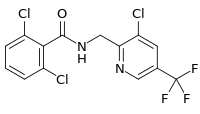Fluopicolide
Fluopicolide is a fungicide used in agriculture to control diseases caused by oomycetes such as late blight of potato. It is classed as an acylpicolide and its chemical name is 2,6-dichloro-N-[[3-chloro-5-(trifluoromethyl)-2-pyridinyl]methyl] benzamide.[1] The precise mode of action is not known, but it is thought to act by affecting spectrin-like proteins in the cytoskeleton of oomycetes.[1][2] This mode of action differs from other available fungicides used to control oomycetes and it can inhibit the growth of strains that are resistant to phenylamides, strobilurin, dimethomorph and iprovalicarb.[1] It has some systemic activity as it moves through the xylem towards the tips of stems, but does not get transported to the roots.[2] It affects the motility of zoospores, the germination of cysts, the growth of the mycelium and sporulation.[3] Bayer CropScience developed the compound and it was first released as a commercial product in 2006.[4]
 | |
| Names | |
|---|---|
| IUPAC name
2,6-Dichloro-N-{[3-chloro-5-(trifluoromethyl)-2-pyridinyl]methyl}benzamide | |
| Identifiers | |
3D model (JSmol) |
|
| ChEBI | |
| ChemSpider | |
| ECHA InfoCard | 100.110.208 |
PubChem CID |
|
| UNII | |
CompTox Dashboard (EPA) |
|
| |
| |
| Properties | |
| C14H8Cl3F3N2O | |
| Molar mass | 383.58 g·mol−1 |
Except where otherwise noted, data are given for materials in their standard state (at 25 °C [77 °F], 100 kPa). | |
| Infobox references | |
Uses
Fluopicolide has been shown to be effective at controlling Phytophthora infestans, Phytophthora capsicii, Phytophthora porri, Plasmopara viticola, Perenospora parasitica, Peronospora tabacina, Peronospora sparsa, Pseudoperonospora cubensis and Bremia lactucae. As of 2007, it was only available commercially as a co-formulation with Fosetyl-Al for use in vines (as Profiler) and as a co-formulation with propamocarb for use on potatoes and vegetables (as Infinito). Other products were in development.[5]
Toxicity
The median lethal dose in rats is >5000 mg/kg meaning that fluopicolide has low acute toxicity.[2][5] Tests in other mammals indicate that it does not cause skin sensitisation, cancer or developmental problems.[5]
References
- Valérie Toquin, Marie-Pascal Latorse, and Roland Beffa (2012). Modern Crop Protection Compounds. John Wiley & Sons. pp. 831–838. ISBN 978-3-527-32965-6.CS1 maint: uses authors parameter (link)
- "Fluopicolide Toxicology" (PDF). Food and Agriculture Organization.
- U. Gisi; Ilan Chet; Maria Lodovica Gullino (18 September 2009). Recent Developments in Management of Plant Diseases. Springer Science & Business Media. p. 19. ISBN 978-1-4020-8804-9.
- "Bayer CropScience`s Infinito receives best combined rating". Biotech Week. 2007-06-20.
- Valérie Toquin; Francois Barja; Catherine Sirven; Roland Beffa (2007). "Fluopicolide, a new Anti-oomycetes Fungicide with a New Mode of Action inducing Perturbation of a Spectrin-like Protein". Modern Crop Protection Compounds. doi:10.1002/9783527619580.ch19.